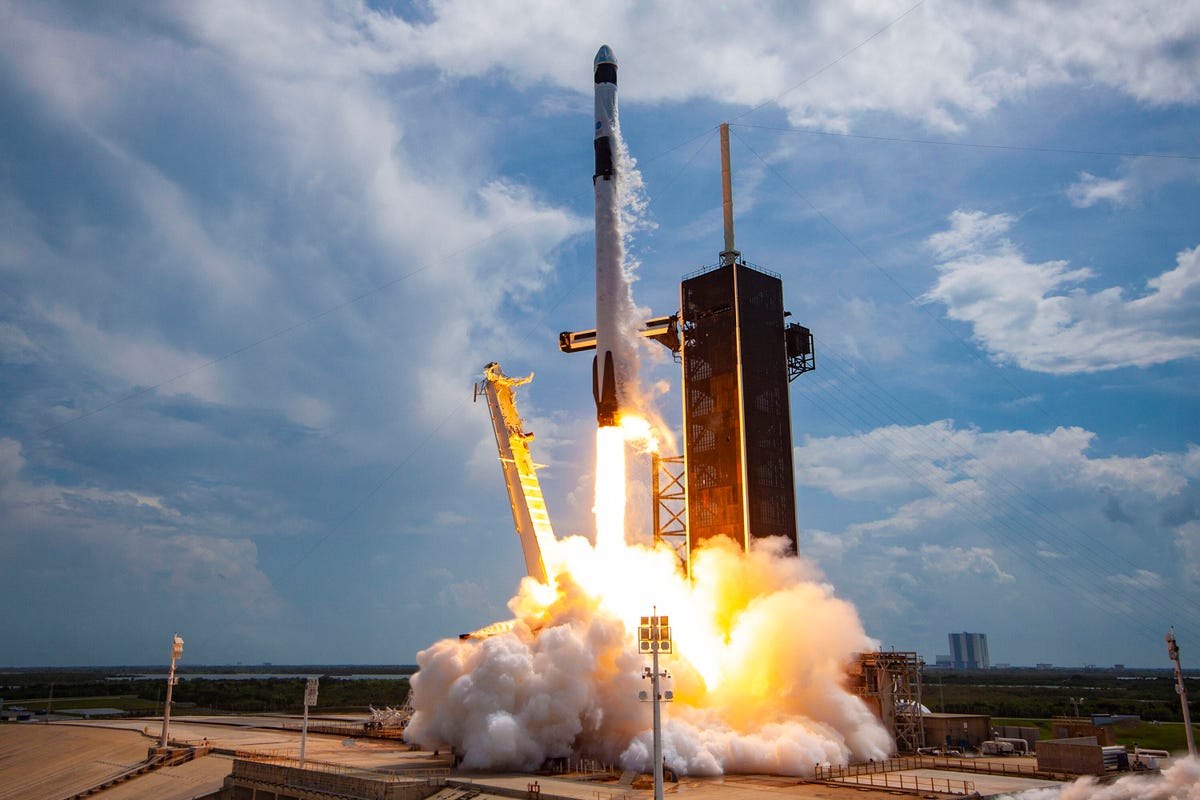Scenes of SpaceX launching NASA astronauts into orbit, moment by moment
It's the first time a SpaceX rocket carried humans. They rode inside the Crew Dragon capsule on the way to the International Space Station.

SpaceX Falcon 9 launch
SpaceX's Crew Dragon spacecraft, perched atop the company's Falcon 9 rocket, takes off from launch pad 39A at the Kennedy Space Center in Cape Canaveral, Florida, carrying NASA astronauts Robert Behnken and Douglas Hurley to the International Space Station. The May 30 launch was the first US rocket launch with a crew since the Space Shuttle program ended in 2011 and SpaceX's first crewed mission ever. The mission is called Demo-2 since its primary purpose is to test out SpaceX's spacecraft.
SpaceX's Falcon 9 rocket in the sky
Weather threatened to cause a second delay to SpaceX's Falcon 9 rocket launch from Cape Canaveral, but clouds cleared and the launch went ahead.
SpaceX Crew Dragon before docking
The mission succeeded in delivering SpaceX's Crew Dragon to the International Space Station. This image shows it minutes before docking.
SpaceX Falcon 9 and Crew Dragon launch
The Falcon 9 begins ascending seconds after ignition. The Crew Dragon capsule, carrying NASA astronauts Robert Behnken and Douglas Hurley to the International Space Station, is perched at the top of the rocket. It was the first crewed launch by a SpaceX rocket.
Social distancing during SpaceX Crew Dragon launch
Because of the coronavirus pandemic, people space themselves apart using social distancing recommendations while witnessing the launch of SpaceX's Crew Dragon spacecraft.
SpaceX Falcon 9 clears the tower
The Falcon 9 rocket clears the launch pad equipment at Cape Canaveral, Florida.
SpaceX Falcon 9 launch
SpaceX's Falcon 9 rocket blasts upward to propel the Crew Dragon capsule into orbit.
SpaceX Falcon 9 traveling fast
The Falcon 9 rocket, shown here from below, rises atop a plume of exhaust at 1 minute 50 seconds after launch. It's traveling at at 3,052 kilometers per hour at an elevation of 31.8 kilometers at this moment.
SpaceX Falcon 9 and Crew Dragon launch
The mission has succeeded so far. Here, the second stage of the Falcon 9 rocket falls away after separating from the Crew Dragon capsule 12 minutes after launch. The Crew Dragon has a 19-hour journey to higher orbit to bring astronauts Robert Behnken and Douglas Hurley to the International Space Station.
SpaceX Falcon 9 and Crew Dragon launch
SpaceX staff, each wearing a mask during the coronavirus pandemic, monitor the launch of their Falcon 9 rocket and Crew Dragon capsule from the company headquarters in Hawthorne, California.
Two halves of SpaceX Falcon 9 rocket
At right, the Falcon 9 main stage returns to Earth, where it landed on SpaceX's drone ship for later reuse. At left, the Merlin engine of the second stage of the rocket continues to burn to boost the Crew Dragon capsule into orbit.
SpaceX Falcon 9 and Crew Dragon launch
At left, the Falcon 9 main stage rests shortly after landing on SpaceX's drone ship, named Of Course I Still Love You. At right, astronauts Robert Behnken and Douglas Hurley to mark the occasion inside the Crew Dragon capsule. They face the blue glow of several touch screens that are a major computing upgrade from earlier spacecraft.
NASA's Mission Control for SpaceX launch
NASA's Mission Control in Houston oversaw the launch from Cape Canaveral, Florida.
SpaceX Crew Dragon launches atop Falcon 9 rocket
SpaceX's Crew Dragon spacecraft, perched atop the company's Falcon 9 rocket, takes off from launch pad 39A at the Kennedy Space Center in Cape Canaveral, Florida, carrying NASA astronauts Robert Behnken and Douglas Hurley to the International Space Station. The May 30 launch was the first US rocket launch with a crew since the Space Shuttle program ended in 2011 and SpaceX's first crewed mission ever. The mission is called Demo-2 since its primary purpose is to test out SpaceX's spacecraft.

